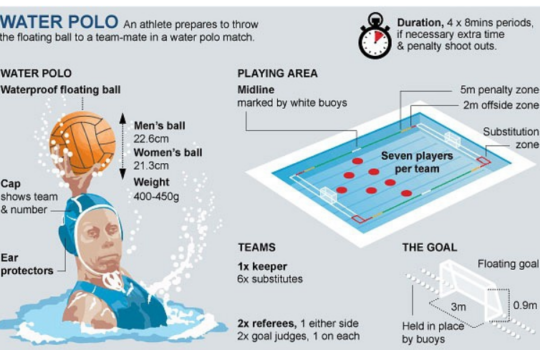
The game starts with all players lined up at their own goal line. The referee blows a whistle and throws the ball into play at mid-pool. The swimmers sprint to their positions, with players from each team swimming to get possession of the ball.
Swimmers either pass the ball to other teammates, swim with the ball as they move forward (sort of like dribbling a basketball), or take a shot at the goal to score a point. A shot must be taken before time expires or ball possession changes.
A goal is scored when the ball completely crosses the goal line, an imaginary surface across the front of the goal. The ball could go part-way in and be pulled out by the goalie – this would not be considered a goal.
Fouls
All fouls result in a change in possession of the ball or a penalty shot if it occurred within a zone 5-meters from the goal. There are minor fouls (one whistle blast from the referee) which results in just a change in possession. A major foul (two whistle blasts) results in the guilty player removal from the game for a 20-seconds, which creates unbalanced situations. When possession changes, the offense gets a free throw from the spot of the foul, an unhindered chance to pass the ball to another player within about 3-seconds.
Examples of fouls include:
Minor Fouls
- Pushing the ball underwater (even if you are forced to do so by a defensive player)
- Touching the ball with both hands
- Coming into contact with the arm of a player that has the ball
- Hitting the ball with a fist
- Throwing the ball out-of-bounds
- Pushing of the pool side, pool bottom, or another player
Major Fouls
- Intentionally holding the player with the ball
- Interfering with a free throw
- Pushing another player underwater (called sinking the player)
- Swearing
- Player with the ball intentionally pushing another player (offensive foul in basketball)
